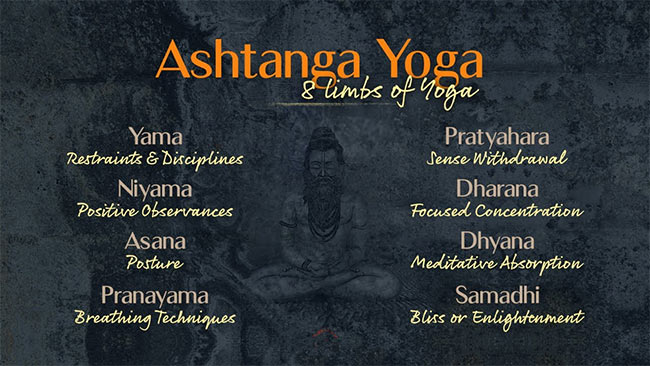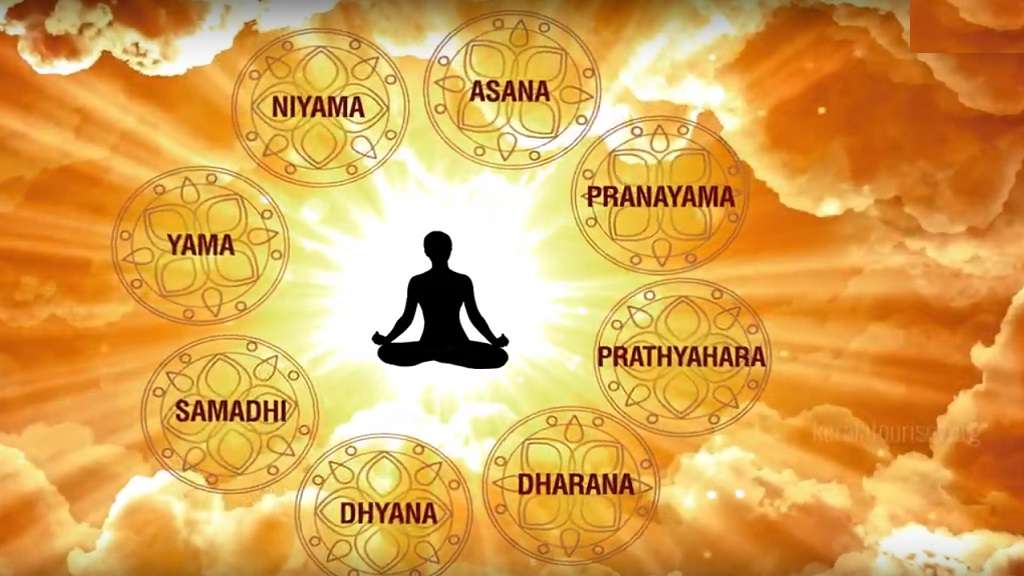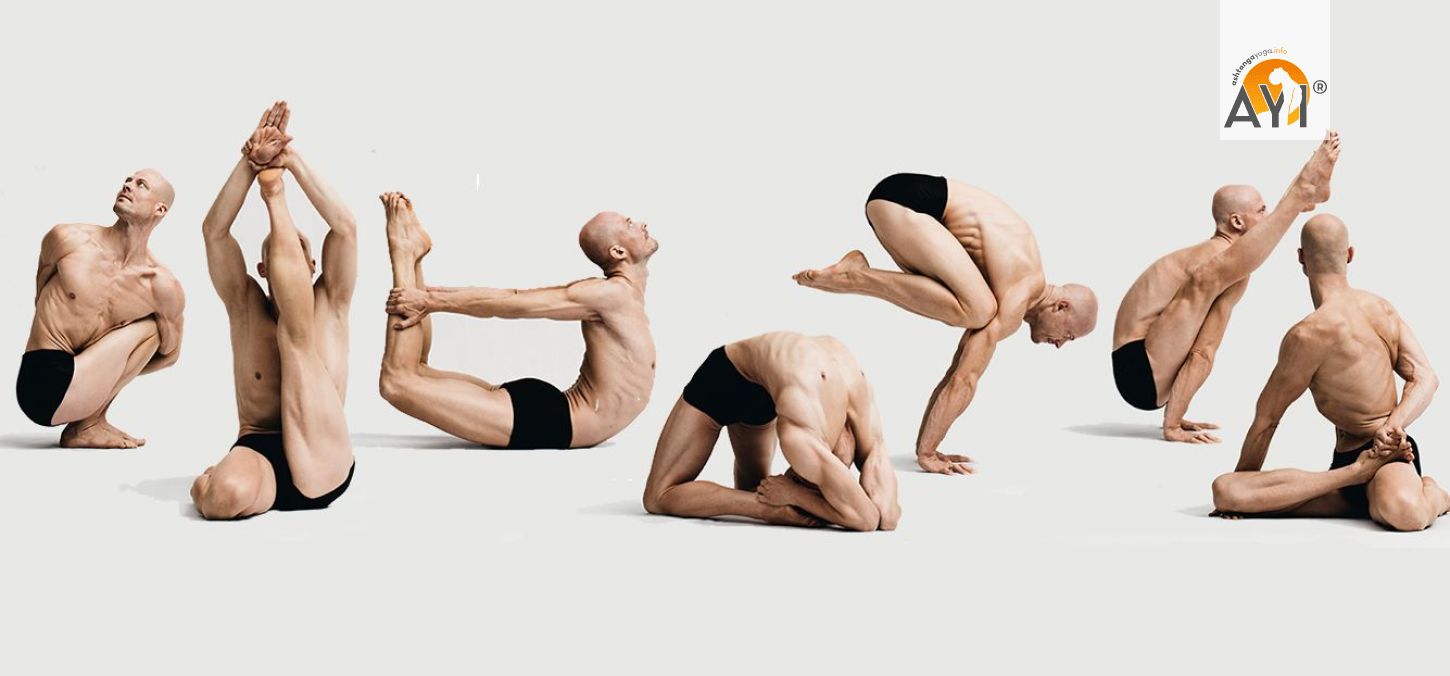Table of Contents
What is Ashtanga Yoga
In Sanskrit Ashtanga means Eight Limbs. Ashtanga is made from a combination of two words – “Ashta + Anga”, wherein “Ashta” means Eight and “Anga” is limbs so it means Eight Limb path. There are two popular styles of Ashtanga Yoga – the first one being “Patanjali’s Ashtanga Yoga” which refers to the classical eight-fold path of yoga outlined by the sage Patanjali in the Yoga Sutras; the second one being Ashtanga Yoga (Modern Yoga Style), popularized by Shri K. Pattabhi Jois which involves a dynamic sequence of postures practiced in a specific order, synchronized with breath and internal focus.
Patanjali Ashtanga Yoga
Patanjali Ashtanga yoga is based on the Yoga Philosophy of Sage Patanjali who defined Ashtanga Yoga in one Sutra – ‘Yogas Chitta Vritti Nirodhah‘ – which means by the suppression of the modifications of the mind-stuff or restraining the thought waves, a man obtains Yoga. Ashtanga Yoga is the Royal Road to freedom from misery.
Patanjali’s Yoga Sutras, written around 200 BCE, describes the philosophy and practices of yoga. In this context, “Ashtanga” refers to the eight limbs or components of yoga, as outlined by Patanjali. These limbs provide a comprehensive framework for living a balanced and purposeful life, incorporating both physical and mental aspects. The eight limbs are:
- Yama (ethical guidelines)
- Niyama (self-discipline and spiritual observances)
- Asana (physical postures)
- Pranayama (breath control)
- Pratyahara (withdrawal of senses)
- Dharana (concentration)
- Dhyana (meditation)
- Samadhi (self-realization)
Ashtanga Yoga Steps
The term “Ashtanga Yoga” can refer to the classical eight-fold path of yoga outlined by Patanjali in the Yoga Sutras, or it can refer to the modern style of yoga developed by Sri K. Pattabhi Jois. Here we provide an overview of both interpretations:
8 limbs of Ashtanga yoga (Patanjali’s Eight-Fold Path)
Patanjali’s Ashtanga Yoga consists of eight limbs or steps that guide a practitioner toward self-realization and inner peace. These limbs are meant to be practiced in a sequential and integrated manner:
- Yama (Ethical Guidelines): These are moral restraints, including non-violence, truthfulness, non-stealing, sexual restraint, and non-greediness.
- Niyama (Self-Discipline and Spiritual Observances): These are personal observances, including cleanliness, contentment, self-discipline, self-study, and surrender to a higher power.
- Asana (Physical Postures): The practice of physical postures helps cultivate steadiness and comfort in the body to prepare for meditation.
- Pranayama (Breath Control): Breath control techniques help regulate and expand the vital life force (prana), leading to better control over the mind.
- Pratyahara (Withdrawal of Senses): Turning inward by withdrawing the senses from external stimuli to focus on inner awareness.
- Dharana (Concentration): Developing the ability to focus the mind on a single object, thought, or point of concentration.
- Dhyana (Meditation): Deepening the state of concentration into a continuous flow of thought, leading to meditation and inner contemplation.
- Samadhi (Self-Realization): The ultimate goal of yoga, where the practitioner experiences a state of oneness, transcendence, and self-realization.
Ashtanga Yoga According to Modern Style (Sri K. Pattabhi Jois)
Ashtanga Yoga in the modern sense refers to a physically demanding style of yoga developed by Sri K. Pattabhi Jois. It involves a set sequence of postures, divided into different series, which are practiced in a flowing and dynamic manner. Here are the steps for practicing Ashtanga Yoga in this style:
- Sun Salutations: The practice typically begins with a series of Sun Salutations (Surya Namaskara A and B), which serve as warm-up exercises and help synchronize breath with movement.
- Standing Postures: After the Sun Salutations, a series of standing postures are practiced to build strength, balance, and flexibility.
- Seated Postures: The practice then moves to a sequence of seated postures, which further work on flexibility and strength.
- Finishing Sequence: The practice concludes with a set of finishing postures, including inversions and relaxation poses.
- Breath and Bandhas: Throughout the practice, emphasis is placed on ujjayi breath (a specific breathing technique) and engaging energy locks called bandhas to support and enhance the practice.
- Mysore Style: Ashtanga Yoga is often taught in a Mysore-style format, where students memorize the sequence and practice at their own pace under the guidance of a teacher.
Remember that both interpretations of Ashtanga Yoga—Patanjali’s eight-fold path and the modern yoga style—involve dedicated practice and a commitment to personal growth and self-discovery.
Also, read –
Jnana Yoga – The Yoga Of Wisdom – Most Difficult Of The Four Paths Of Yoga
Bhakti Yoga – Easiest Of The Four Yogic Paths To Enlightenment



